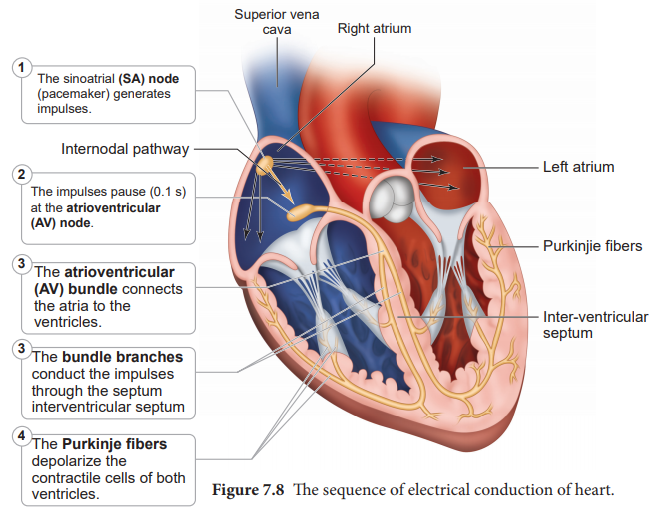The nurse is reviewing the sequence of the cardiac cycle. The nurse recognizes that the electrical stimulus of the cardiac cycle follows which sequence?
AV node-SA node bundle of His- bundle branches
SA node- AV node-bundle of His -bundle branches
Bundle of His- AV node- SA node- Erb's Point
AV node-SA node-bundle of His- Erb's Point
The Correct Answer is B
A. AV node - SA node - bundle of His - bundle branches:
This sequence is incorrect. The SA node (sinoatrial node) initiates the electrical impulse in the heart, followed by the AV node (atrioventricular node), bundle of His, and then the bundle branches.
B. SA node - AV node - bundle of His - bundle branches:
This sequence is correct. The electrical stimulus of the cardiac cycle starts at the SA node, which is the natural pacemaker of the heart. From the SA node, the impulse travels to the AV node, then to the bundle of His, and finally to the bundle branches, which distribute the impulse to the ventricles, causing them to contract.
C. Bundle of His - AV node - SA node - Erb's Point:
This sequence is incorrect. Erb's Point is a point on the chest where heart sounds S2 and S3 can be heard most distinctly.
D. AV node - SA node - bundle of His - Erb's Point:
This sequence is incorrect. The AV node comes after the SA node in the electrical conduction system of the heart. Erb's Point is not a part of the normal cardiac conduction pathway; it is a location for auscultation on the chest.
Nursing Test Bank
Naxlex Comprehensive Predictor Exams
Related Questions
Correct Answer is C
Explanation
A. Friction rub:
A friction rub is a grating or rubbing sound or sensation heard or felt during auscultation or palpation. It occurs when inflamed pleural or pericardial surfaces rub against each other during breathing or heartbeats, respectively.
B. Tactile fremitus:
Tactile fremitus refers to the palpable vibrations transmitted through the bronchopulmonary tree to the chest wall as the patient speaks. It is assessed by placing hands on the patient's back while the patient speaks certain words. Increased tactile fremitus can occur in conditions with lung consolidation, such as pneumonia.
C. Crepitus:
Crepitus is a crackling or grating sensation felt under the skin or heard when the ends of a broken bone rub against each other. It can also occur when air leaks into subcutaneous tissue, leading to a crackling sensation upon palpation.
D. Adventitious sounds:
Adventitious sounds refer to abnormal lung sounds heard during auscultation. These sounds include crackles (rales), wheezes, rhonchi, and pleural friction rubs. Adventitious sounds can indicate various respiratory conditions, such as pneumonia, bronchitis, or asthma.
Correct Answer is C
Explanation
A. Nystagmus in extreme superior gaze: Nystagmus is an involuntary eye movement and is not a normal finding, especially in extreme superior gaze. Nystagmus can be indicative of neurological issues and requires further evaluation.
B. Slight amount of lid lag when moving the eyes from a superior to an inferior position: Lid lag refers to a delay in the downward movement of the upper eyelid during eye movement. This can be a sign of hyperthyroidism and is not a normal finding.
C. Parallel movement of both eyes: This is the correct answer. During the diagnostic positions test, the nurse should observe parallel movement of both eyes in all directions, indicating normal extraocular muscle function and coordination.
D. Convergence of the eyes: Convergence refers to the inward movement of both eyes when focusing on a close object. While convergence is a normal phenomenon, it is not specifically assessed during the diagnostic positions test, which primarily evaluates the range of motion and coordination of the extraocular muscles.
Whether you are a student looking to ace your exams or a practicing nurse seeking to enhance your expertise , our nursing education contents will empower you with the confidence and competence to make a difference in the lives of patients and become a respected leader in the healthcare field.
Visit Naxlex, invest in your future and unlock endless possibilities with our unparalleled nursing education contents today
Report Wrong Answer on the Current Question
Do you disagree with the answer? If yes, what is your expected answer? Explain.
Kindly be descriptive with the issue you are facing.
